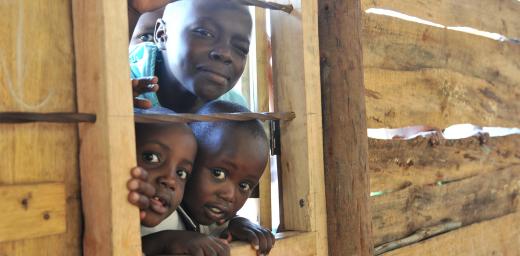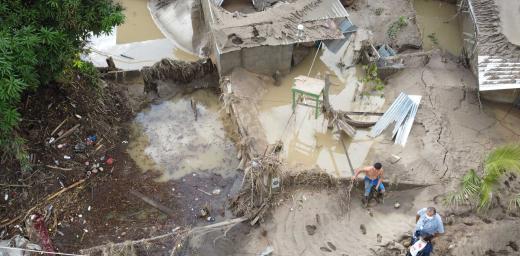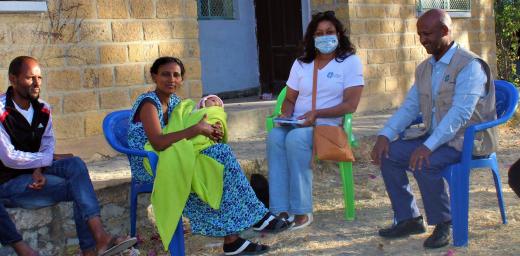FEATURE: Namibia on the Tipping Point
Magdaline's family depends on her monthly pension for survival. Photo: LWF/Thomas Ekelund
LWF Response to Ease Burden on Pensioners and Livestock Owners
WINDHOEK, Namibia/GENEVA, 27 August 2013 (LWI) - Sixty-five-year-old Magdaline says she was on the road for four days, travelling the 150 kilometers from her village to the closest city, Mariental in south-central Namibia. Accompanied by her brother and his four children including six-month-old David, they rode in an open horse carriage, sleeping on the road side at night. The month of August falls in the winter season, when temperatures often drop below zero at night.
Magdaline and her family had travelled to collect the USD 90 (around 930 Namibian dollars) that she receives per month as old-age pension. The family has nothing else to live off as Namibians cope with the country’s worst drought in nearly three decades.
“My brother does not have a job, the animals and crops do not survive and I barely have food for the children. I was given ten goats by the government but when the town counselor came and took them back I had nothing,” says Magdaline, referring to a government program that helps farmers increase their livestock. In the current situation, many are compelled to sell some of the animals to buy fodder or they may die altogether.
When Namibian President Hifikepunye L. Pohamba declared a national emergency in May this year, he called for assistance to cope with the crisis that is affecting nearly 40 percent of the 2.1 million people in the country. The four previous years recorded heavy rains, causing flooding that destroyed crops. But meteorologists say the 166 millimeters of rainfall during the last eight months is the lowest in 30 years.
The rural population mainly relies on livestock and crop production, sectors which are now severely affected by the drought. Magdaline’s family, like 80 percent of households in Namibia, own livestock—cattle, goats, sheep, donkeys and poultry—which are a source of milk and meat for the family, or they can be sold for money. The drought has significantly reduced grazing pastures and water availability, threatening the animals’ survival and their commercial value. Estimates from the government Emergency Food Security Assessment (EFSA) indicate that more than 4,000 livestock deaths have been reported.
Impact on Livelihoods
The impact on livelihoods is multifaceted. In the past a cow would sell at 3,000 Namibian dollars, but the value has decreased to as little as 260 dollars. Before the drought, a goat sold at 700 to 800 dollars, but it now goes for about 300 to 450 dollars. In the commercial farming areas, farmers are turning to other alternatives, including taking their cattle to neighboring South Africa where they can fetch relatively higher prices.
The World Bank lists Namibia as a middle-income country although a quarter of its people live in poverty. Unemployment is estimated at around 37 percent, with inequality of wealth and access to services being amongst the highest in the world. The current drought exacerbates the situation for communities that normally depend on commercial farms, as they are left with little or no income at all. The abattoirs that provide seasonal labor have in some cases shut down, only adding to the unemployment levels.
While agriculture accounts for only five percent of the national economy and a third of Namibians depend on some form of subsistence farming, food production relies on over 70 percent of the country’s fresh water sources. Government estimates show that cereal production in 2013 is likely to decrease by 42 percent compared to last year. Half of the households in the drought-affected areas reported that none or hardly any of the millet planted in December was growing. During a normal year, families can store grains to last up to six or seven months, but many of the households now say what they had put aside has been depleted. In some parts of the country, the yields are sinking daily.
LWF and Churches Together
Through the United Church Council of Namibia Evangelical Lutheran Churches, The Lutheran World Federation (LWF) is working with its partners in the ACT Alliance network to help rural communities cope with the drought. The overall goal is to alleviate suffering through immediate relief assistance.
It is the first time that the LWF member churches in the country—Evangelical Lutheran Church in the Republic of Namibia (ELCRN), Evangelical Lutheran Church in Namibia (ELCIN) and the German-speaking Evangelical Lutheran Church in Namibia—are responding to an ACT drought appeal. The affected households will get cash to cover their basic needs; receive psychosocial support; gain knowledge about resilience in responding to future disasters, as well as capacity to advocate for their rights.
Long-Term Impact
For families like Magdaline’s, a food crisis presents other challenges. Apart from the more obvious increased risks of malnutrition, deteriorating health and loss of income, inability to feed one’s family can sometimes mean turning to negative coping mechanisms such as alcohol consumption. The prolonged dry spell also forces students to drop out of school, and for those who stay on, the learning ability is seriously affected.
As no harvest is foreseen until March 2014, an LWF assessment predicts the situation will deteriorate rapidly without urgent outside intervention.
Namibia and neighboring Angola are facing the severest drought in over a quarter of a century, with some 800,000 Namibians categorized as food insecure. In the Angolan border provinces of Cunene and Namibe, over 600,000 inhabitants do not have enough food or water due to two consecutive years of failed rains.
(By LWF communications consultant Thomas Ekelund, during a recent visit to Namibia)





